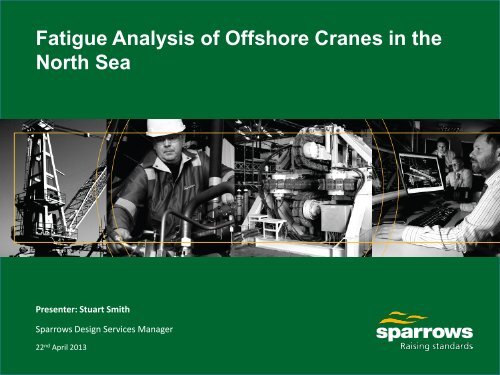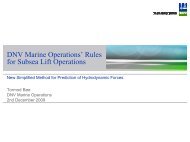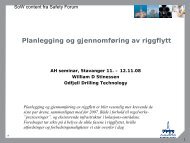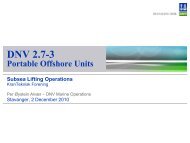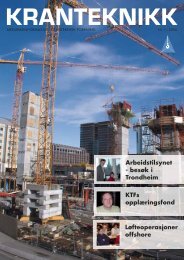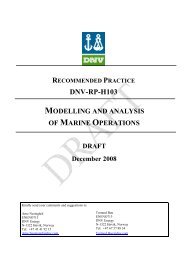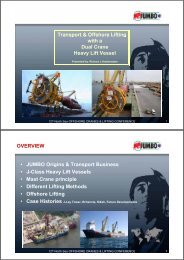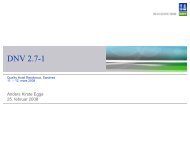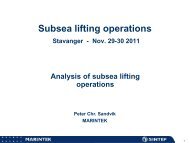4.0 Structural Analysis
4.0 Structural Analysis
4.0 Structural Analysis
You also want an ePaper? Increase the reach of your titles
YUMPU automatically turns print PDFs into web optimized ePapers that Google loves.
Fatigue <strong>Analysis</strong> of Offshore Cranes in theNorth SeaPresenter: Stuart SmithSparrows Design Services Manager22 nd April 2013
A fully integrated service offering
Content1.0 Introduction2.0 Theoretical Background3.0 Fatigue Load Determination<strong>4.0</strong> <strong>Structural</strong> <strong>Analysis</strong>5.0 Determination of Fatigue Life6.0 Post <strong>Analysis</strong> Integrity Consideration7.0 Conclusion
1.0 Introduction• Design life generally 25 - 30 years depending on codesand cycles experienced• Crane Manufacturers Approach• Current Regular inspections interval under scrutiny byindustry authorities• Requests for evidence – HSE - The Ageing and LifeExtension Inspection Programme KP4• Valuable data for decision makingSection 1.0 Section 2.0 Section 3.0 Section <strong>4.0</strong> Section 5.0 Section 6.0 Section 7.0
1.0 IntroductionLiterature reviewHSE Reports• Literature survey on fatigue strengths of load-carrying filletwelded joints failing in the weld• Fatigue life enhancement of tubular joints by grout injectionPublished papers• Application of the hot spot stress method to hollowsection ship Loader Boom Connections• How to achieve valid results in durability analysis from FEAsoftwareCrane Design Codes• BS 2573 rules for the design of Cranes• API2C Specification for Offshore Pedestal Mounted Cranes• Lloyds Code for Lifting Appliances in a Marine Environment• DNV - 2.22 lifting appliancesMain point of reference for this analysis• DNV – RP 203 Fatigue Design of Offshore Steel Structures2010Section 1.0 Section 2.0 Section 3.0 Section <strong>4.0</strong> Section 5.0 Section 6.0 Section 7.0
1.0 Introduction– Summary of our methodology– Based on realistic loads and cycles– Focus on known fatigue issues – basedon Sparrows experienceSection 1.0 Section 2.0 Section 3.0 Section <strong>4.0</strong> Section 5.0 Section 6.0 Section 7.0
1.0 IntroductionStartReview of LoadIndicator dataorReview ofCargo dataorReview of loadcurve againstLSFDetermine crane fatigue cycles& number of liftsCreate crane FE modelDetermine fatigue loadingsRun <strong>Structural</strong> analysis andcalculate Stress RangeDetermine Sensitive PositionsDetermine DNV S-N curveaccording to weld typesCalculate Fatigue lifeSection 1.0 Section 2.0 Section 3.0 Section <strong>4.0</strong> Section 5.0 Section 6.0 Section 7.0
2.0 Theoretical Background– Fatigue life - bases on Stress RangeStress RangeRelevant S/N curve• Mean stress effect is neglected– Accumulative damage using Miner’s ruleSection 2.0Section 1.0 Section 3.0 Section <strong>4.0</strong> Section 5.0 Section 6.0 Section 7.0
2.0 Theoretical BackgroundStress range– Cannot be obtained directly– Problematic due to the number of variables todeal with in a working crane– Due to this we consider the load cycle as thestarting point for analysisSection 2.0Section 1.0 Section 3.0 Section <strong>4.0</strong> Section 5.0 Section 6.0 Section 7.0
3.0 Fatigue Load DeterminationLoad Cycle– Extrapolating Crane Load Indicator Data– Radius Groups• Mean Load• Mean Radius• Total number of lifts Per Group per yearSection 3.0Section 1.0 Section 2.0 Section <strong>4.0</strong> Section 5.0 Section 6.0 Section 7.0
Load Cycle3.0 Fatigue Load Determination– Model runs• Selected radius for each group• Equation used to calculate averageradiusSection 3.0Section 1.0 Section 2.0 Section <strong>4.0</strong> Section 5.0 Section 6.0 Section 7.0
Load Cycle3.0 Fatigue Load Determination– Cargo Data– Radius Considerations• Survey of Platform• Laydown Areas• Areas of high useSection 3.0Section 1.0 Section 2.0 Section <strong>4.0</strong> Section 5.0 Section 6.0 Section 7.0
Load Cycle3.0 Fatigue Load Determination– Load Curve– Radius Considerations• Survey of Platform• Laydown Areas• Areas of high useSection 3.0Section 1.0 Section 2.0 Section <strong>4.0</strong> Section 5.0 Section 6.0 Section 7.0
<strong>4.0</strong> <strong>Structural</strong> <strong>Analysis</strong>Stress range• Loading conditions• Model runs– Interpretation of resultsMinimum Stress(MPa)Maximum Stress(MPa)Governing MinimumStress (MPa)Stress Range(MPa)Group Radius 1 20 250 20 230Group Radius 2 25 310 20 290Group Radius 3 35 170 20 150Group Radius 4 40 150 20 130Section <strong>4.0</strong>Section 1.0 Section 2.0 Section 3.0 Section 5.0 Section 6.0 Section 7.0
<strong>4.0</strong> <strong>Structural</strong> <strong>Analysis</strong>Stress Range –4 Different stress types considered• Plated structures weld –Maximum Principal Stress• Fillet welded Tubular Joints –Von Mises Equivalent StressSection <strong>4.0</strong>Section 1.0 Section 2.0 Section 3.0 Section 5.0 Section 6.0 Section 7.0
<strong>4.0</strong> <strong>Structural</strong> <strong>Analysis</strong>• Full Penetration Tubular Joints – Hot Spot Stress (Stress Superposition)• Calculate the Stress Concentration Factor(SCF)• Calculate the hot spot stress 8 positionsImages courtesy of DNVSection <strong>4.0</strong>Section 1.0 Section 2.0 Section 3.0 Section 5.0 Section 6.0 Section 7.0
<strong>4.0</strong> <strong>Structural</strong> <strong>Analysis</strong>For structural components where it is problematic to evaluate the‘Nominal Stress’ – use derived Hot Spot StressImages courtesy of DNVSection <strong>4.0</strong>Section 1.0 Section 2.0 Section 3.0 Section 5.0 Section 6.0 Section 7.0
<strong>4.0</strong> <strong>Structural</strong> <strong>Analysis</strong>Determining sensitive positions• Interrogating Models• Different joint types – Create groups• High stress ranges• Our experience of problem areasTheoretical<strong>Analysis</strong>SparrowsExperienceSpecificDataSection <strong>4.0</strong>Section 1.0 Section 2.0 Section 3.0 Section 5.0 Section 6.0 Section 7.0
5.0 Determination of Fatigue LifeWeld Types and S/N curves• S-N curve depends on both weldconnection type and load direction• D-curve for Derived Hot Spot Stress(Detail FE <strong>Analysis</strong>) SCF to be appliedseparately to this curve• T-curve for Tubular Joints (FullPenetration Weld), Same to D-curve• F-curve generally used for FullPenetration Weld –• W3-curve for fillet weldsImages courtesy of DNVSection 5.0Section 1.0 Section 2.0 Section 3.0 Section <strong>4.0</strong> Section 6.0 Section 7.0
5.0 Determination of Fatigue LifeFatigue life calculationDifferent RadiusGroup modelsconsidered inanalysisMiner’s Ruleused tocalculateaccumulativeDamageFatigue lifein YearsLocation S-N Curve Beam No Node NoRadiusGroup 1Damage Ratio at each Radius GroupRadiusGroup 2RadiusGroup 3RadiusGroup 4AnnualDamageLife(years)Head end of 1st middle, upper W3 1 33 0.001004 0.006201 0.013513 0.004827 0.025852 38.68Foot end of 2nd middle, upper W3 935 421 0.001005 0.006491 0.011373 0.004829 0.023698 42.2Middle of 2nd middle, upper W3 937 438 0.000906 0.005853 0.011565 0.004399 0.022722 4<strong>4.0</strong>1Middle of 1st middle, upper W3 39 31 0.000922 0.005904 0.011044 0.004294 0.022164 45.12Head end of 2nd middle, upper W3 906 443 0.00091 0.005972 0.010593 0.004536 0.022011 45.43Middle of 2nd middle, upper W3 935 437 0.000885 0.005664 0.011046 0.004302 0.021897 45.67Middle of 2nd middle, upper W3 938 439 0.00085 0.00551 0.011063 0.004181 0.021604 46.29Foot end of 3rd middle, upper W3 1080 451 0.000827 0.005422 0.010717 0.004177 0.021143 47.3Middle of 2nd middle, upper W3 940 441 0.000826 0.005381 0.01045 0.004104 0.020761 48.17Middle of 1st middle, upper W3 36 27 0.000875 0.005474 0.010381 0.003763 0.020493 48.8Middle of 1st middle, upper W3 37 29 0.000847 0.005393 0.010407 0.003812 0.020459 48.88Section 5.0Section 1.0 Section 2.0 Section 3.0 Section <strong>4.0</strong> Section 6.0 Section 7.0
5.0 Determination of Fatigue LifeStartReview of LoadIndicator dataorReview ofCargo dataorReview of loadcurve againstLSFDetermine crane fatigue cycles& number of liftsCreate crane FE modelDetermine fatigue loadingsRun <strong>Structural</strong> analysis andcalculate Stress RangeDetermine Sensitive PositionsDetermine DNV S-N curveaccording to weld typesCalculate Fatigue lifeSection 5.0Section 1.0 Section 2.0 Section 3.0 Section <strong>4.0</strong> Section 6.0 Section 7.0
5.0 Determination of Fatigue LifeCriticality assessment– What is this– What is the process– End resultSection 5.0Section 1.0 Section 2.0 Section 3.0 Section <strong>4.0</strong> Section 6.0 Section 7.0
6.0 Post <strong>Analysis</strong> Integrity Considerations– Detailed report giving– Knowledge of sensitive locations– Know where to look– Feed into maintenance strategySection 6.0Section 1.0 Section 2.0 Section 3.0 Section <strong>4.0</strong> Section 5.0 Section 7.0
6.0 Post <strong>Analysis</strong> Integrity ConsiderationsInspections– Frequency of Inspections should not bedecreased – May want to increasefrequency– Be specific about where inspections arerequired - i.e. not a full inspection – 10%sample– Preparation of Crane inspection Manual -weld maps– Maintain records– Reducing riskSection 6.0Section 1.0 Section 2.0 Section 3.0 Section <strong>4.0</strong> Section 5.0 Section 7.0
6.0 Post <strong>Analysis</strong> Integrity Considerations– Ultrasonic peening of weld toes to improve life– Upgrade / replacement / keep in service– Future campaignsSection 6.0Section 1.0 Section 2.0 Section 3.0 Section <strong>4.0</strong> Section 5.0 Section 7.0
7.0 Conclusion• Culmination of data from a 4 year program• Process developed over 12 cranes, 9 Models, over 300 Years of crane use• Our results compare well with actual inspection finding• Commercially viable method• Provide guidance for future prevention• Maintaining crane structural integrityQUESTIONS?Stuart.Smith@sparrowsgroup.comSection 1.0 Section 2.0 Section 3.0 Section <strong>4.0</strong> Section 5.0 Section 6.0Section 7.0


